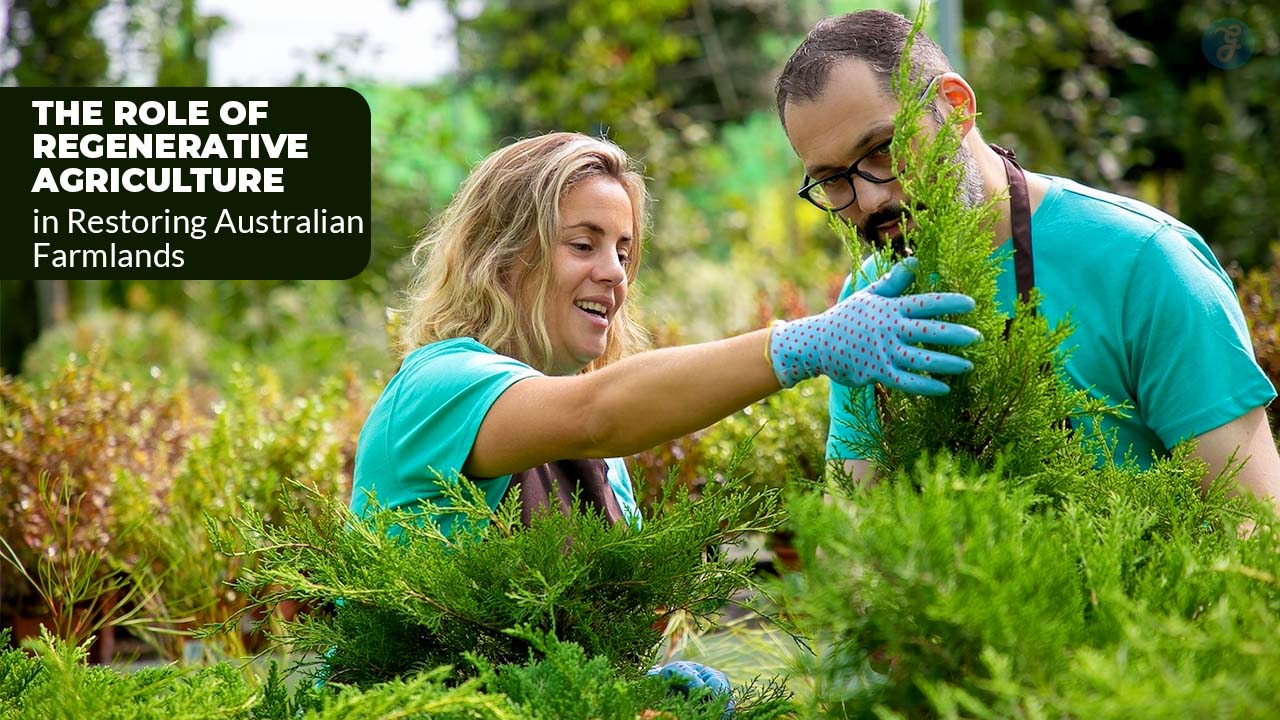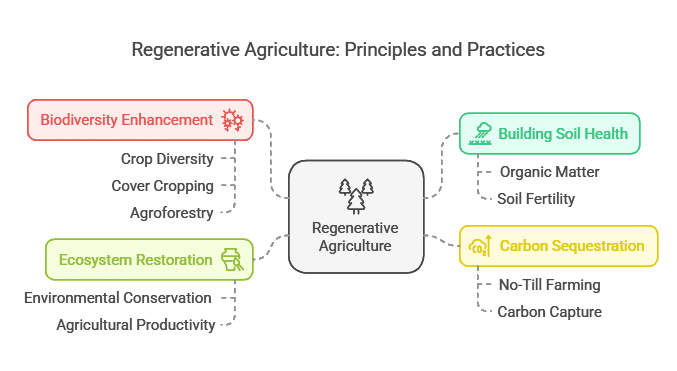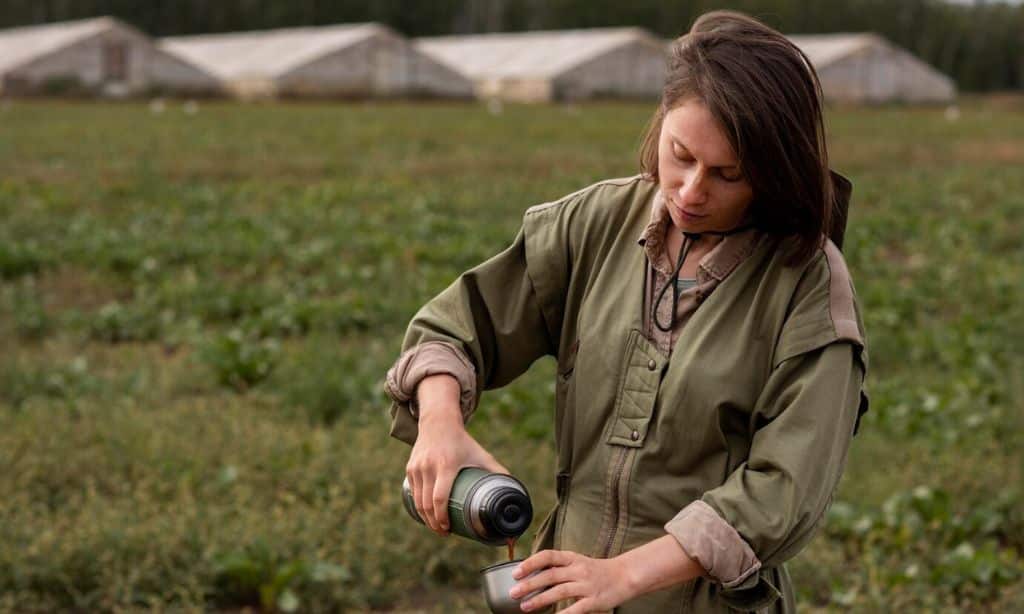Regenerative agriculture in Australian farmlands is more than a buzzword—it is a transformative movement reshaping the future of farming. As farmers confront challenges like climate change, soil degradation, and declining biodiversity, regenerative practices have emerged as a beacon of hope.
By focusing on soil health, ecosystem restoration, and sustainable productivity, this farming approach not only ensures long-term agricultural viability but also paves the way for economic resilience and environmental sustainability. In the same way how crypto will shape the economy, regenerative agriculture is shaping Australia’s farming future.
This article delves into what regenerative agriculture entails, its critical importance to Australian farmlands, and its potential to revolutionize farming practices.
What is Regenerative Agriculture?
Regenerative agriculture is an ecological approach to farming that prioritizes restoring and enhancing soil health, improving biodiversity, and sequestering carbon to combat climate change. Unlike conventional farming methods, which often deplete soil and ecosystems, regenerative practices aim to rejuvenate them. Key principles include:
- Building Soil Health: Emphasis on techniques that promote organic matter and soil fertility.
- Biodiversity Enhancement: Integrating crop diversity, cover cropping, and agroforestry.
- Carbon Sequestration: Adopting practices like no-till farming to capture atmospheric carbon in the soil.
- Ecosystem Restoration: Balancing agricultural productivity with environmental conservation.
| Key Principles of Regenerative Agriculture | Description |
| Building Soil Health | Focus on organic matter and nutrient cycles. |
| Biodiversity Enhancement | Encourages diverse plant and animal life. |
| Carbon Sequestration | Reduces greenhouse gases in the atmosphere. |
| Ecosystem Restoration | Rebalances natural processes in farmlands. |
These practices align with the ethos of resilience, much like the way how crypto will shape the economy by decentralizing and diversifying financial systems.
Why is Regenerative Agriculture Vital for Australian Farmlands?
Australia’s farmlands face a significant challenge—soil degradation. Over 60% of the country’s agricultural soils are considered degraded due to intensive farming practices, overgrazing, and deforestation. Poor soil health leads to reduced crop yields, increased vulnerability to erosion, and a decline in water retention capacity. Regenerative agriculture offers a solution by:
- Improving Soil Organic Matter: Practices like composting and cover cropping enhance soil fertility.
- Restoring Soil Structure: Minimizing tillage reduces soil compaction and erosion.
| Challenges in Soil Health | Solutions Through Regenerative Practices |
| Erosion and Soil Loss | No-till farming, cover cropping. |
| Nutrient Depletion | Composting, rotational planting. |
| Declining Water Retention | Improved soil organic matter. |
Combating Climate Change with Sustainable Farming
Australian agriculture contributes significantly to greenhouse gas emissions. However, regenerative farming practices can turn this narrative around by sequestering carbon in the soil and reducing emissions from synthetic fertilizers. Just as how crypto will shape the economy by decentralizing financial power, regenerative farming decentralizes the control of carbon emissions and builds resilience against climate change.
| Impact of Conventional Farming | Impact of Regenerative Farming |
| High Carbon Footprint | Carbon sequestration in soil and plants. |
| Loss of Biodiversity | Restoration of ecosystems. |
| Water-Intensive Practices | Improved water retention in soil. |
Key Benefits of Regenerative Agriculture in Australian Farmlands
- Reduced Input Costs: Eliminating synthetic fertilizers and pesticides lowers costs. By transitioning to regenerative methods, farmers often experience reduced reliance on expensive external inputs, which improves their financial resilience.
- Increased Yields: Improved soil health leads to more resilient and productive crops over time. Healthy soils create conditions that sustain productivity even during adverse weather.
- Market Opportunities: Growing consumer demand for sustainable products allows farmers to command premium prices. Certification programs like “Carbon Neutral Farming” further enhance profitability.
| Economic Benefits | Explanation |
| Reduced Costs | Less spending on fertilizers and chemicals. |
| Increased Yields | Better soil health leads to consistent harvests. |
| Higher Market Value | Sustainable labels attract eco-conscious buyers. |
Environmental Impact
- Improved Biodiversity: Native plants and wildlife thrive alongside crops. Regenerative farms create habitats that encourage pollinators and predators, reducing the need for chemical pest control.
- Enhanced Water Retention: Healthy soils absorb and store more water, reducing irrigation needs and helping farms adapt to drought conditions.
- Carbon Storage: Practices like agroforestry and rotational grazing increase carbon capture, making agriculture a solution rather than a contributor to climate change.
Case Study: Success Stories of Australian Farmers
In Queensland, a farmer adopted regenerative practices, including rotational grazing and multi-species cover cropping. Over five years, they observed:
- A 40% increase in crop yields.
- Improved soil water retention, reducing irrigation needs by 30%.
- A 50% reduction in operational costs.
| Before Transition | After Transition |
| High Input Costs | Reduced costs by eliminating chemicals. |
| Soil Erosion | Stable soils with no-till farming. |
| Low Yields | Significant yield increases due to healthy soil. |
Strategies for Implementing Regenerative Agriculture in Australia
- No-Till Farming: Prevents soil disturbance and erosion. For example, farmers in New South Wales adopting no-till practices have reduced soil erosion by 70% within three years.
- Cover Cropping: Protects soil from erosion and enhances fertility. Using multi-species cover crops has shown a 30% improvement in soil nutrient levels.
- Rotational Grazing: Improves pasture quality and prevents overgrazing, as demonstrated by farmers in Victoria who reported healthier livestock and higher milk yields.
- Agroforestry: Integrates trees with crops to boost biodiversity and carbon storage, increasing farm profitability while creating wildlife habitats.
| Technique | Traditional Farming | Regenerative Farming |
| Soil Preparation | Intensive tilling | No-till farming |
| Crop Diversity | Monoculture | Multi-species planting |
| Pest Management | Synthetic pesticides | Natural pest predators |
| Carbon Impact | High emissions | Carbon sequestration |
Government Support and Policy Initiatives
Australian governments have begun supporting regenerative farming through grants, subsidies, and educational programs. For example:
- Landcare Grants: Funding for farmers adopting sustainable practices.
- Carbon Farming Initiatives: Incentives for carbon sequestration projects.
- Future Drought Fund: Provides resources for farmers to improve resilience against extreme weather.
| Policy Initiative | Key Benefit |
| Landcare Grants | Supports sustainable land management practices. |
| Carbon Farming Initiatives | Rewards carbon sequestration efforts. |
| Future Drought Fund | Helps farmers prepare for climate challenges. |
Challenges Facing Regenerative Agriculture in Australian Farmlands
Adopting regenerative practices often requires significant changes in mindset, skills, and infrastructure. Farmers may hesitate due to:
- Financial risks during the transition period.
- Lack of knowledge about regenerative methods.
- Uncertainty about long-term benefits.
Lack of Awareness and Education
Many farmers are unaware of the long-term benefits of regenerative agriculture. Bridging this gap requires:
- Comprehensive training programs tailored to specific regions.
- Community-driven workshops where experienced farmers share their success stories.
| Challenges | Proposed Solutions |
| Resistance to Change | Incentives, demonstration projects. |
| Lack of Knowledge | Farmer training and community workshops. |
| Financial Risks | Subsidies and grants for transitional costs. |
Solutions to Overcome These Challenges
- Education Campaigns: Partnering with agricultural organizations to spread awareness and provide hands-on training.
- Incentive Programs: Providing financial support to mitigate risks during the transition.
- Technology Integration: Leveraging data-driven tools to guide and monitor regenerative practices. For instance, soil health monitoring apps are increasingly helping farmers track their progress in real time.
The Future of Regenerative Agriculture in Australia
Regenerative agriculture is poised to redefine Australian farming. As consumer awareness about sustainability grows, so does the demand for ethically produced goods. In the next decade, Australia can become a global leader in regenerative farming, much like how crypto will shape the economy by driving decentralized innovation. The integration of technology, supportive policies, and farmer education will be key to realizing this vision.
| Future Trends | Implications |
| Increased Consumer Demand | Boosts profitability for regenerative farmers. |
| Advances in Technology | Data-driven tools enhance efficiency. |
| Government Policy Support | Encourages widespread adoption. |
Wrap Up
Regenerative agriculture in Australian farmlands represents a pivotal shift toward sustainable and resilient farming. By restoring soil health, improving biodiversity, and addressing climate challenges, these practices ensure long-term viability for farmers and ecosystems alike.
Much like how crypto will shape the economy, regenerative agriculture empowers individuals to make transformative choices that benefit society. As more farmers embrace these methods, Australia can lead the world in sustainable agricultural innovation.







































